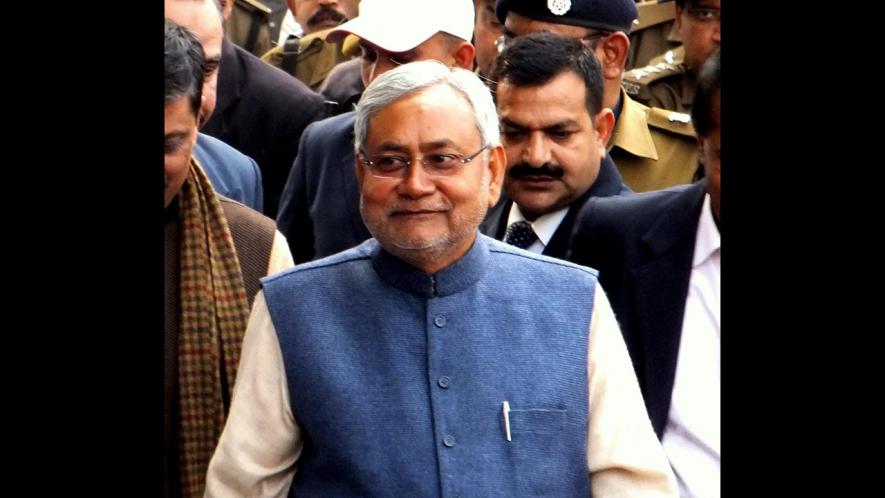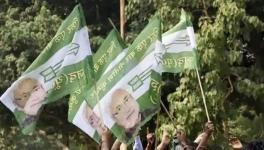Chirag Should Know: Nitish is a Potato in Bihar Politics

Nitish Kumar. | Image Courtesy: WIkipedia
It is debatable whether Lok Janshakti Party president Chirag Paswan has heard of that arcane phrase—“hoist with his own petard.” The phrase is used to describe a person whose plan to cause trouble for others blows up on him. Chirag is ambitious and wants to turn the LJP into a formidable force. Yet his blueprint for the future is predicated on nixing the chance of Nitish Kumar to become the chief minister of Bihar for yet another term. Or, to put it another way, on proving that the LJP’s usefulness to the Bharatiya Janata Party is more than that of Nitish’s Janata Dal-United.
In the 2015 Assembly elections, the LJP won two seats and secured 4.83% of the total votes cast. The party’s vote-share was, however, an impressive 29.79% in the 42 seats it contested. The LJP was then in alliance with the BJP; the JD-U was with Lalu Prasad Yadav’s Rashtriya Janata Dal and the Congress. Essentially a Dalit party, a good many BJP voters voted for the LJP in the 42 constituencies it contested.
The JD-U’s return to the National Democratic Alliance implied that the LJP was to be allocated less than 42 seats in 2020. Unwilling to accept a diminished share of seats and see the LJP’s vote-share decline, Chirag has chosen to break away from the NDA in a decidedly peculiar fashion. He will field candidates in all constituencies where the NDA candidate will be from the JD-U. But his party will not contest against BJP candidates. Given that the BJP has been allocated half of the Bihar Assembly’s 243 seats, the LJP will be fielding nearly three times more candidates than it did in 2015.
Fighting outside the NDA umbrella will yield gains to Chirag on four counts, said Nawal Kishore Chaudhry, former head of the economics department, Patna University. “He can accommodate the aspirational rank and file of his party, which will surely see its vote-share increase. It helps him to convey that he has taken over from [Union Minister] Ram Vilas Paswan, his father. And as is true for all parties, I suppose the LJP will get money from candidates who will be assigned its tickets,” he said.
Chirag’s decision is about demonstrating that the LJP has a better capacity than the JD-U to transfer its votes to the BJP or anyone else for that matter. The LJP’s mainstay are the Dusadhs, who comprise nearly one-third of Bihar’s 15% Dalit population. In the rough and tumble of rural India politics, Dusadhs have it in them not only to exercise their franchise, but also ensure other Dalit communities do so, never a certainty in the Hindi belt.
This has Dr Amit Kumar, former in-charge of Patna College’s Sanskrit Department, to argue, “They can act as aggregators of Dalit voters. On top of it, LJP can transfer its Dalit votes to whoever it wants. Forget the reserved constituencies, where the key to winning rests with other communities, there are 30 to 40 constituencies where Dalit votes can play a significant role.”
Amit Kumar should know these details—he was once with the LJP and then left it to fight on the ticket of the All-India Majlis-e-Ittehadul Muslimeen in the 2015 Assembly election. This is how the logic he puts forth will work out: In constituencies where the BJP will field candidates, the LJP will not contest. That will be a signal to Dalits to vote for the BJP. And in those constituencies where the JD-U will field candidates, so will the LJP. In such constituencies, Dalits will opt for the LJP. Minus the Dalit votes, the JD-U will have to largely depend on its own support base among the Most Backward Castes for victory.
What about the BJP’s formidable support among the upper castes? It is precisely here the phrase “hoist with his own petard” acquires relevance.
At the nub of Chirag’s strategy to harm JD-U is the assumption that the BJP and its supporters, particularly the upper castes among them, want their own chief minister—and not play second-fiddle to Nitish Kumar all over again. Their perception is that the year 2020 is just ripe for it. There is anti-incumbency working against Nitish Kumar. His own caste of Kurmi is numerically not so significant, and it is moot whether his base among Most Backward Castes and women remain intact.
Thus, by fielding candidates against JD-U candidates, Chirag is signalling the upper castes to vote for the LJP, which has publically avowed to support the BJP—and, therefore, also its chief ministerial candidate post-election.
Chirag’s expectations, in turn, can fructify only if the upper castes believe his manoeuvres have the BJP’s tacit approval. Such is the popular perception of Prime Minister Narendra Modi’s sway over the NDA and his policy of giving no quarter to those working against his plan, few think Chirag could have acted without a wink and nudge from him.
DM Diwakar, former director of the prestigious AN Sinha Institute of Social Studies, Patna, said, “People do think Chirag is acting at the BJP’s behest. He announced he would field candidates against the JD-U only after the RJD-Congress-Left announced the ratio of seat distribution among themselves. Nitish, therefore, ran out of options.” Diwakar said the lesson the BJP drew from the 2015 election was that the “alliance of which [Nitish] Kumar is part forms the government”. Kumar was checkmated from going anywhere else.
“I have been talking to BJP activists, and they do indeed say that Chirag’s decision has been interpreted as suitable for the BJP’s ambitions,” said Rakesh Ranjan, associate professor of political science, Patna University, who assists the Centre for the Study of Developing Societies, Delhi, to conduct poll surveys in Bihar. But these are still early days. Voters will look for coded messages until 7 November, the last leg of the Bihar elections.
“People will wait to see whether Modi holds rallies only in BJP-dominated areas or will he also do so, with equal fervour, in areas traditionally regarded as JD-U’s turf,” said Ranjan. “But voting decisions based on such signals could also lead to confusion. Unexpected victories with narrow margins could also happen,” he said.
Ultimately then, Nitish and Chirag’s fate will depend on the perception and voting behaviour of the upper castes. Amit Kumar said, “The upper castes/upper class voters are the most aware of all social groups. They are also those who wish to play every which way. Between JD-U and LJP, they will see whose candidates suit them best, in every constituency.”
Thus, in case the JD-U fields a Most Backward Caste candidate and the LJP a strong upper caste candidate, then the upper castes will swing behind the LJP. If both field upper caste candidates, then it would depend on who among the two is considered better. “It should be remembered that it is not that the upper castes dominate every part of the State. In this election, anyone polling 40,000 could emerge a winner, with a narrow margin,” Amit Kumar said.
Narrow margins of victory mean Chirag might get hoisted with his own petard. Nawal Kishore Chaudhary is emphatic, “Chirag will adversely affect the NDA’s core, which is the BJP-JD (U). Mark my words, Nitish Kumar will, once again, become chief minister.” But what if the JD-U’s seats are less than the BJP’s? “If the Congress can align with the Shiv Sena, why will it have a problem supporting Nitish Kumar? Even the Left will not have a problem supporting him and the RJD can always be persuaded,” Chaudhary said.
In other words, as long as the JD-U’s size does not dwindle to an extent where it can be easily split, Nitish Kumar will remain in the race to become the chief minister. Rakesh Ranjan invokes a telling imagery to explain the phenomenon of Nitish Kumar: “Potato can be put in both a vegetarian and mutton dish. Nitish Kumar is the potato of Bihar politics.” He will matter unless the RJD-Congress-Left cross the majority mark on their own.
The author is an independent journalist. The views are personal.
Get the latest reports & analysis with people's perspective on Protests, movements & deep analytical videos, discussions of the current affairs in your Telegram app. Subscribe to NewsClick's Telegram channel & get Real-Time updates on stories, as they get published on our website.
























